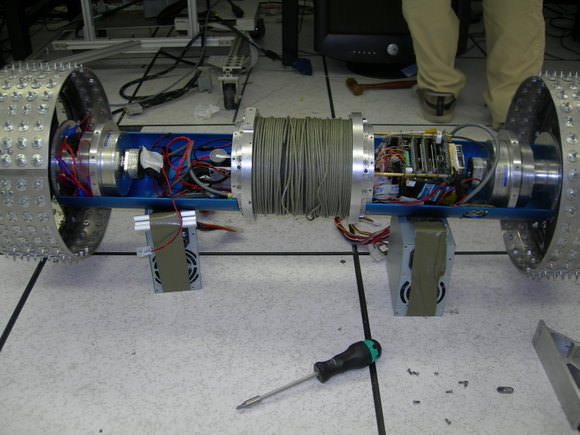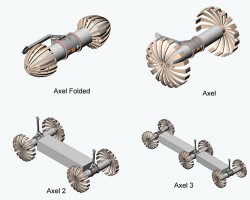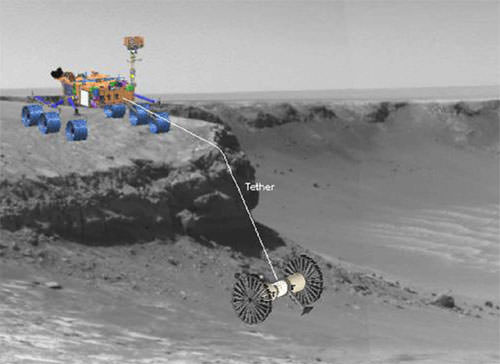If you’ve looked at the high resolution HiRISE images from the Mars Reconnaissance Orbiter, or had the chance to explore the new Google Mars, you know Mars is fraught with craters, mountains, gullies, and all sorts of interesting – and dangerous – terrain. Areas such as these with layered deposits, sediments, fracturing and faulting are just the type of places to look for the sources of methane that is being produced on Mars.
But it’s much too risky to send our current style of rovers, including the 2011 Mars Science Laboratory (MSL), into treacherous terrain. But engineers from JPL, along with students at the California Institute of Technology have designed and tested a versatile, low-mass robot that could be added to larger rovers like MSL that can rappel off cliffs, travel nimbly over steep and rocky terrain, and explore deep craters.
This prototype rover, called Axel, might help future robotic spacecraft better explore and investigate foreign worlds such as Mars. On Earth, Axel might assist in search-and-rescue operations.
Watch a video showing an Axel test-run at the JPL Mars yard.
“Axel extends our ability to explore terrains that we haven’t been able to explore in the past, such as deep craters with vertically-sloped promontories,” said Axel’s principal investigator, Issa A.D. Nesnas, of JPL’s robotics and mobility section. “Also, because Axel is relatively low-mass, a mission may carry a number of Axel rovers. That would give us the opportunity to be more aggressive with the terrain we would explore, while keeping the overall risk manageable.”
Nesnas said Axel is like a yo-yo — it is on a tether attached to a larger rover and can go up and down the sides of craters, canyons and gullies, exploring regions not safe for other rovers.

The simple and elegant design of Axel, which can operate both upside down and right side up, uses only three motors: one to control each of its two wheels and a third to control a lever. The lever contains a scoop to gather lunar or planetary material for scientists to study, and it also adjusts the robot’s two stereo cameras, which can tilt 360 degrees.

Axel’s cylindrical body has computing and wireless communications capabilities and an inertial sensor to operate autonomously. It also sports a tether that Axel can unreel to descend from a larger lander, rover or anchor point. The rover can use different wheel types, from large foldable wheels to inflatable ones, which help the rover tolerate a hard landing and handle rocky terrain.
Axel has been in development since 1999, and students from Caltech, Purdue University, and Arkansas Tech University have collaborated with JPL over the years to develop this versatile rover.
For more information on Axel, see JPL’s Axel page, and Caltech’s Axel website.


Interessant.
I really appreciate how they constantly improve surface vehicles from the research of failed vehicles and discovering far more hazards than previously imagined. I realize this new craft will not eventually be the answer but a stepping stone to more research and technology not now known
for improved surface vehicles able to truely survive the terrain and incredible dust storms of Mars
I read some years back in a Discover magazine the best vehicle may be something that can mimic a Cockroach! It may sound ridiculous, however, a cockroach actually uses its 2 back feet and the front ,middle legs are raised off the ground when fleeing from danger.-however, this reseach and development , production will be a long protracted timeframe, perhaps centuries..
But remember, this is just one idea, but IMHO,has some merit compared to other ideas I heard about.
In the photo of Axel, it looks like it’s resting on 2 PC power supplies that have some support ridges taped on, so that it won’t roll off. What will those NASA engineers think of next?
cipater- although it appears they are using duct tape and bailing wire to keep the device together, it is interesting just to see the
components inside of the axle , the wheels are interesting.
I think NASA should fund robot wars on TV
Man, I like the idea, but given how cautious the Spirit and Opportunity drivers have to be with their rovers, can you imagine the amount of time and caution it will take even to situate the main rover close to the edge of a precipitous cliff — not to mention having to dangle the “yo-yo” over cliff faces that they most likely have not had the chance to scope out first?
Of course, one would have to hope that along with the next generation rovers comes the next generation in autonomous robotic software, because it’s going to take some serious processing power (and algorithmic genius) to drive these things into potential harm’s way without taking too much time or risk doing it!
I just hope they remember to give the rover the ability to cut loose the Axel, last thing you want is for Axel’s tether to snag and have a perfectly good rover stuck with it…
Snags in a river etc are annoying enough when fishing, imagine the frustration of one millions of miles away!
tacitus
Luke Garratt
tacitus-it appears they had the foresight to have a build-in ground burrowing or hugging ‘foot break’ in the rear-but, I hope the ground the ‘footbreak’ is on is relatively solid. I agree the next gereration or 2 of quasi-autonomous robotic software will eventually be required,lets hope Moore’s law of computer processing continues -about the year 2019 or so, with todays technology – Moore’s law may reach the end unless there’s a breakthrough -perhaps optical or quantum computers will replace our current integrated-circuit technology -but much research is required. The processing power for autonomous robots will be enormous, our current super-computers can’t handle the requirements, perhaps 5-10 or more generalions of Moore’s law and it will be possible to have such processing power for the robots using a small area of robot space..
Luke, I really hope the Axels’ tether does not snag, losing the Axei will be a big loss, but I’m certain, the developers will have the foresight to be able to ‘cut the cord’ as a last resort. Lets just hope some eager-beaver
rover-operator will not get into something over their heads and loss the Axei.
robby, I agree that there will be improvements in the technology, but the one thing to bear in mind is that deep space missions rarely, if ever, fly with the latest and greatest available. They are usually several years behind, at least, mostly so that they can use components that are hardened and proven reliable over many months — and years — of service. So, for a mission due to launch in 2019, you talking technology of circa 2015 or even earlier (when you add in the development, building, and testing time).
I assume those guys (and gals) know what they’re doing, but they don’t have as much time as others usually think they do.
Zeppelin!
Duct tape is the closest we have to a universal application material. It saved the Apollo 13 astronauts. It is holding Axel together. If you ever go to the Smithsonian Air and Space Museum located at Dulles Airport, VA, you will see a Mercury capsule. It was supposed to be used for the last flight, but NASA terminated the project early as all goals had been met. The museum put the craft into orbital configuration for display. The nose cone is held on with duct tape. And yes, the inventors of WD-40 were trying to make a lubricant for the space program. It was only after the people working on it starting to take cans home that the makers realized they had a great product on their hands. And then there is velcro. Duct tape, WD-40, and velcro, our keys to space.
I have some reservations. Yes, for the likes of a Victoria Crater, that is a workable solution, but if you are going to the edge of some of the deepest valleys, then you are entering into a whole new ball game. A five mile deep valley plus the slope will require a tether probably as much as six miles long. The weight and additional size of the reel and consequential additional energy requirements for the use of such a length of suitably strong line will alone make the concept difficult to say the least. Some terrain is more than ten miles from the surface to the bottom.
At the end of the day, all one wants is to be able to drop a sub system down from an aerial platform. Surely a controllable density balloon would make a more elegant solution for the deeper valleys?
tacitus-you are absolutely right about any deep spaces missions using latest technology, besides having to be hardened against solar radiation and think about the static electricity! I’m certain the current rovers used suitable computer tech per 1995-if anyone can remember what advancements windows 95 had over DOS, awesome then,but if anyone got or rebuilt their PC within the last year they would think of the W-95 as a joke. If the Axei rover arrives on Mars 2019 I think they will be using current or perhaps 2010 as latest suitable ‘puter tech.
as research, testing, hardening requirements, still this will be far more capable than our current rovers which far exceeded task expectations and lifespans of the developers and others. You are also correct about timeframes, I was hopping all along they can think things out before jumping into something beyond their prudent capabilities,- perhaps NASA and other space agencies have to better communicate to the lay person space exploration is a slow process requiring a long time and has dangers not imagined here on Earth. It is true what may be science fiction may become science fact, but there is much science fiction which will remain fiction forever (I think about a ridiculous SiFi movie-2 earth thugs in black leather jackets jumping off their spaceship on the moon without protective suits looking to beat up someone ROTFLMAO) . If people believes this movie can be fact, oh well.Lol.
Marco-also the 3 very important products every household must/should have. The history of velcro, someone made mad but had a cooler head to study something natural clinging to their clothes, awesome!!!
We take those 3 products for granted today as expectations, without them;;;not very good.
Wow, you just gotta love those robots!
RT
http://www.online-anonymity.at.tc
Chris Coles- I believe about 500 feet is plenty deep enough for a cliff and the maximum amount of cable the Axel will carry will not be much more. A far more capable rover using technology and computer power not now known/available will not require the Axel.
Your idea for a controllable density balloon sounds like a very reasonable solution for deep canyons/craters and should be available in a reasonable timeframe– , Imaging viewing from close-up, the ‘canyon of all canyons’ , Valles Marineris !!!
That device looks just like an anchor to me. if anyone has ever fished, they know that you need some way to cut the line at some point. Havingi powered wheels will help a lot, but not a guarantee. Lots of great ideas, though.
sorry Robbie. i just got smart and read the comments and see i echoed you..
I would drop that thing into one of those lava tube holes. They definitely have to take a peek into the one place where the orbiters can’t see.
Awesome little thing! Obviously they’d need some redundant way to cut the line – it does look like a great anchor after all! But I the concept of missions with a ‘mother rover’ and then numerous mini-rovers or probes that are more highly specialised is an interesting one. Imagine sending something like the MSL that could have a robust set of onboard instruments as well as say, a little solar powered glider, an air balloon of some description, the AXEL, mini rovers, or maybe a micro-robot swarm etc. Obviously there would be a huge deal of technological innovation that must come first, but it’s great to ponder the potential capabilities of such a setup…
Most of you worry about Axel getting stuck or malfunctioning. But what if the mother-rover dies or gets trapped. Can Axel work on its own? Probably not, but they should think about this scenario.
~SeaFire~
what happens if the tether gets tangled up? that seems like what obviously would happen